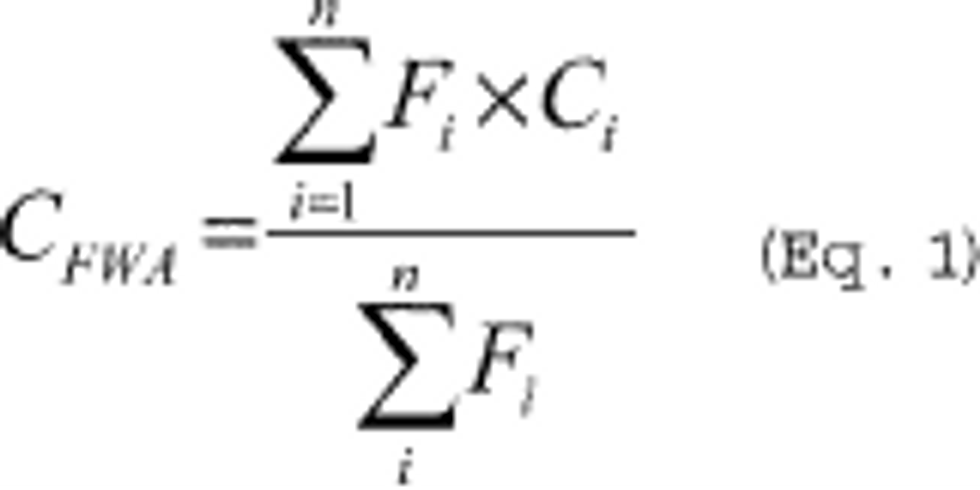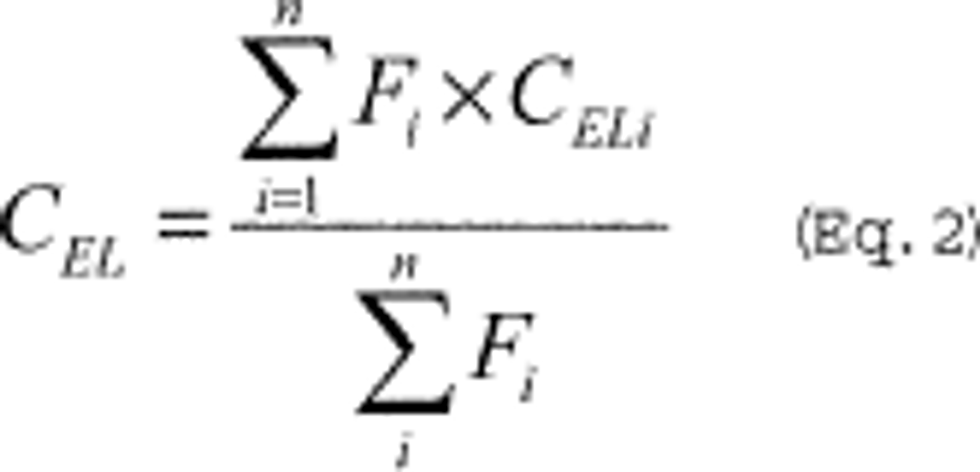['Air Programs']
['Hazardous Air Pollutants']
02/27/2022
...
(a) For existing sources, you must maintain the concentration of lead compounds in any process vent gas at or below 1.0 milligrams of lead per dry standard cubic meter (0.00043 grains of lead per dry standard cubic foot). You must maintain the flow-weighted average concentration of lead compounds in vent gases from a secondary lead smelting facility at or below 0.20 milligrams of lead per dry standard cubic meter (0.000087 grains of lead per dry standard cubic foot).
(1) You must demonstrate compliance with the flow weighted average emissions limit on a 12-month rolling average basis, calculated monthly using the most recent test data available.
(2) Until 12 monthly weighted average emissions rates have been accumulated, calculate only the monthly average weighted emissions rate.
(3) You must use Equation 1 of this section to calculate the flow-weighted average concentration of lead compounds from process vents:

Where:
CFWA = Flow-weighted average concentration of all process vents.
n = Number of process vents.
Fi = Flow rate from process vent i in dry standard cubic feet per minute, as measured during the most recent compliance test.
Ci = Concentration of lead in process vent i, as measured during the most recent compliance test.
(4) Each month, you must use the concentration of lead and flow rate obtained during the most recent compliance test performed prior to or during that month to perform the calculation using Equation 1 of this section.
(5) If a continuous emissions monitoring system (CEMS) is used to measure the concentration of lead in a vent, the monthly average lead concentration and monthly average flow rate must be used rather than the most recent compliance test data.
(b) For new sources that begin construction or reconstruction after May 19, 2011 you must maintain the concentration of lead compounds in any process vent gas at or below 0.20 milligrams of lead per dry standard cubic meter (0.000087 grains of lead per dry standard cubic foot).
(c) You must meet the applicable emissions limits for total hydrocarbons and dioxins and furans from furnace sources specified in Table 2 of this subpart. There are no standards for dioxins and furans during periods of startup and shutdown.
(d) If you combine furnace emissions from multiple types of furnaces and these furnaces do not meet the definition of collocated blast and reverberatory furnaces, you must calculate your emissions limit for the combined furnace stream using Equation 2 of this section.

Where:
CEL = Flow-weighted average emissions limit (concentration) of combined furnace vents.
n = Number of furnace vents.
Fi = Flow rate from furnace vent i in dry standard cubic feet per minute.
CEli = Emissions limit (concentration) of pollutant in furnace vent i as specified in Table 2 of this subpart.
(e) If you combine furnace emissions with the furnace charging process fugitive emissions and discharge them to the atmosphere through a common emissions point, you must demonstrate compliance with the applicable total hydrocarbons concentration limit specified in paragraph (c) of this section at a location downstream from the point at which the two emissions streams are combined.
(f) If you do not combine the furnace charging process fugitive emissions with the furnace process emissions, and discharge such emissions to the atmosphere through separate emissions points, you must maintain the total hydrocarbons concentration in the exhaust gas at or below 20 parts per million by volume, expressed as propane.
(g) Following the initial performance or compliance test to demonstrate compliance with the lead emissions limits specified in paragraph (a) or (b) of this section, you must conduct performance tests according to the schedule in paragraph (g)(1) or (2) of this section.
(1) Conduct an annual performance test for lead compounds from each process vent (no later than 12 calendar months following the previous compliance test), unless you install and operate a CEMS meeting the requirements of �63.8.
(2) If an annual compliance test demonstrates that a process vent emitted lead compounds at 0.10 milligram of lead per dry standard cubic meter or less during the time of the annual compliance test, you may submit a written request to the Administrator applying for an extension of up to 24 calendar months from the previous compliance test to conduct the next compliance test for lead compounds.
(h) Following the initial performance or compliance test to demonstrate compliance with the total hydrocarbons emissions limits in paragraphs (c) and (f) of this section, you must conduct an annual performance test for total hydrocarbons emissions from each process vent that has established limits for total hydrocarbons (no later than 12 calendar months following the previous compliance test), unless you install and operate a CEMS meeting the requirements of �63.8. If an annual compliance test demonstrates that a process vent emitted total hydrocarbons at less than 50 percent of the allowable limit during the time of the annual compliance test, you may submit a written request to the Administrator applying for an extension of up to 24 calendar months from the previous compliance test to conduct the next compliance test for total hydrocarbons.
(i) Following the initial performance or compliance test to demonstrate compliance with the dioxins and furans emissions limits specified in paragraph (c) of this section, you must conduct a performance test for dioxins and furans emissions from each process vent that has established limits for dioxins and furans at least once every 6 years following the previous compliance test.
(j) You must conduct the performance tests specified in paragraphs (g) through (i) of this section under maximum representative operating conditions for the process. During the performance test, you may operate the control device at maximum or minimum representative operating conditions for monitored control device parameters, whichever results in lower emission reduction. Upon request, you must make available to the Administrator such records as may be necessary to determine the conditions of performance tests.
(k) At all times, you must operate and maintain any affected source, including associated air pollution control equipment and monitoring equipment, in a manner consistent with safety and good air pollution control practices for minimizing emissions. Determination of whether such operation and maintenance procedures are being used will be based on information available to the Administrator that may include, but is not limited to, monitoring results, review of operation and maintenance procedures, review of operation and maintenance records, and inspection of the source.
(l) If you own or operate a unit subject to emission limits in Table 2 of this subpart, you must minimize the unit's startup and shutdown periods following the manufacturer's recommended procedures, if available. You must develop and follow standard operating procedures designed to minimize emissions of total hydrocarbon for each startup or shutdown scenario anticipated. You must submit a signed statement in the Notification of Compliance Status report that indicates that you conducted startups and shutdowns according to the manufacturer's recommended procedures, if available, and the standard operating procedures designed to minimize emissions of total hydrocarbons.
(m) In addition to complying with the applicable emissions limits for dioxins and furans listed in Table 2 to this subpart, you must operate a process to separate plastic battery casing materials from all automotive batteries prior to introducing feed into a furnace.
[77 FR 580, Jan. 5, 2012, as amended at 79 FR 371, Jan. 3, 2014]
['Air Programs']
['Hazardous Air Pollutants']
UPGRADE TO CONTINUE READING
Load More
J. J. Keller is the trusted source for DOT / Transportation, OSHA / Workplace Safety, Human Resources, Construction Safety and Hazmat / Hazardous Materials regulation compliance products and services. J. J. Keller helps you increase safety awareness, reduce risk, follow best practices, improve safety training, and stay current with changing regulations.
Copyright 2025 J. J. Keller & Associate, Inc. For re-use options please contact copyright@jjkeller.com or call 800-558-5011.
